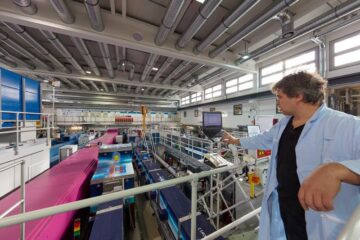A smart video camera understands what it sees

Imagine a smart video camera that automatically makes a note of license plate numbers on cars. It’s more than a camera. It can also analyze the content of images. How can video cameras best be taught to understand and react to what they see? How is the memory used in such a camera?
These are questions that Benny Thörnberg at Mid Sweden University answers in his dissertation on machine vision systems.
Benny Thörnberg has spent five years developing efficient design methods for smart camera electronics. The use of the memory in a smart camera is clearly the greatest challenge facing engineers. Further, the set of tools available to electronics engineers has by no means developed apace with the miniaturization and smarting up of electronics products.
„My dissertation describes a tool that helps designers of systems for machine vision. The tool facilitates programming and optimizes the use of memory in smart cameras,” says Benny Thörnberg.
Fields of application for the technology are numerous. Surveillance of traffic and homes, industrial automation, image enhancement, and night vision systems for cars are just a few examples.
The aim of the project is to develop a smart camera that can gage the size of woodchips. A chipper has to produce tiny chips of wood of roughly even size in order to enable the production of paper pulp and paper of high quality.
A major portion of the work has been carried out in a research project together with a few local companies and the Knowledge Foundation.
„Close collaboration with the local business community is a necessary condition for us to make sure we are researching relevant issues. Industry offers many interesting image analysis problems that are well suited to automation,“ says Benny Thörnberg.
The title of the dissertation is Memory Modeling and Synthesis for Real-Time Video Processing Systems.
Media Contact
Weitere Informationen:
http://www.miun.seAlle Nachrichten aus der Kategorie: Informationstechnologie
Neuerungen und Entwicklungen auf den Gebieten der Informations- und Datenverarbeitung sowie der dafür benötigten Hardware finden Sie hier zusammengefasst.
Unter anderem erhalten Sie Informationen aus den Teilbereichen: IT-Dienstleistungen, IT-Architektur, IT-Management und Telekommunikation.
Neueste Beiträge

Bakterien für klimaneutrale Chemikalien der Zukunft
Forschende an der ETH Zürich haben Bakterien im Labor so herangezüchtet, dass sie Methanol effizient verwerten können. Jetzt lässt sich der Stoffwechsel dieser Bakterien anzapfen, um wertvolle Produkte herzustellen, die…

Batterien: Heute die Materialien von morgen modellieren
Welche Faktoren bestimmen, wie schnell sich eine Batterie laden lässt? Dieser und weiteren Fragen gehen Forschende am Karlsruher Institut für Technologie (KIT) mit computergestützten Simulationen nach. Mikrostrukturmodelle tragen dazu bei,…

Porosität von Sedimentgestein mit Neutronen untersucht
Forschung am FRM II zu geologischen Lagerstätten. Dauerhafte unterirdische Lagerung von CO2 Poren so klein wie Bakterien Porenmessung mit Neutronen auf den Nanometer genau Ob Sedimentgesteine fossile Kohlenwasserstoffe speichern können…





















